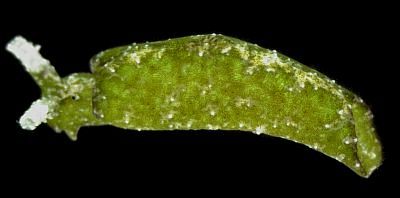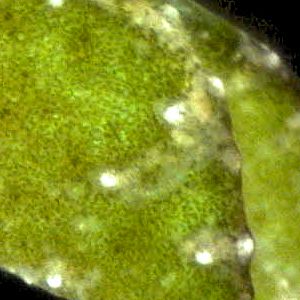

Elysia tuca
Marcus & Marcus, 1967
Order: SACOGLOSSA
Superfamily: ELYSIOIDEA
Family: Elysiidae
DISTRIBUTION
Caribbean, Florida to Brazil.
PHOTO
on Halimeda monile, west coast of Florida. Lower photo: enlarged view of part of parapodia. PHOTOS: Anna Bass.
The animals vary in colour from light to dark green and sometimes to brown. There is usually an opaque white patch on the head behind the rhinophores, and there is a white line from the patch running up the basal half of each rhinophore. Behind that there is another smaller white patch just anterior to the parapodia. There can be white patchng along the parapodial edge. The rhinophores have a white upper region, sometimes the upper half, while the lower half is often mottled with green or brown. The rhinophores often have prominent rounded papillae and there are also scattered papillae, often white on the parapodia. Grows to approx 20 mm long and is usually found feedng on species of the algal genus Halimeda.
In the parapodia there is an intricate network of branching digestive gland ducts [lower right photo] in which the choroplasts from its food are stored. E. tuca is one of the solar powered sacoglossans which keep the chloroplasts from their algal food alive and photosynthesising to produce sugars and other nutrients for their own use.
See Elysiella pusilla, a very similar-looking Halimeda feeder from the Indo-West Pacific.
-
Marcus, Ev. (1980) Review of western Atlantic Elysiidae (Opisthobranchia Ascoglossa) with a description of a new Elysia species. Bull. Mar. Sci. 30(1): 54-79.
-
Waugh, G.R., Clark, K.B. (1986) Seasonal and geographic variation in chlorophyll level of Elysia tuca (Ascoglossa: Opisthobranchia). Marine Biology, 92: 483-487.
Rudman, W.B., 2004 (February 18) Elysia tuca Marcus & Marcus, 1967. [In] Sea Slug Forum. Australian Museum, Sydney. Available from http://www.seaslugforum.net/factsheet/elystuca
Related messages
-
Elysia tuca from Bermuda
From: Kimberly Holzer, September 7, 2007 -
Elysia tuca from the Bahamas
From: Anne DuPont, September 12, 2005 -
Elysia tuca with parasite
From: Marina Poddubetskaia, February 21, 2004 -
Elysia tuca from Southern Bahamas
From: Marina Poddubetskaia, February 20, 2004 -
Elysia tuca from west coast of Florida
From: Anna L. Bass, April 28, 2001 -
Chemoreception in Elysia tuca
From: Charlie Hileman, June 17, 1999
